McClure - Stuart - Hart Family
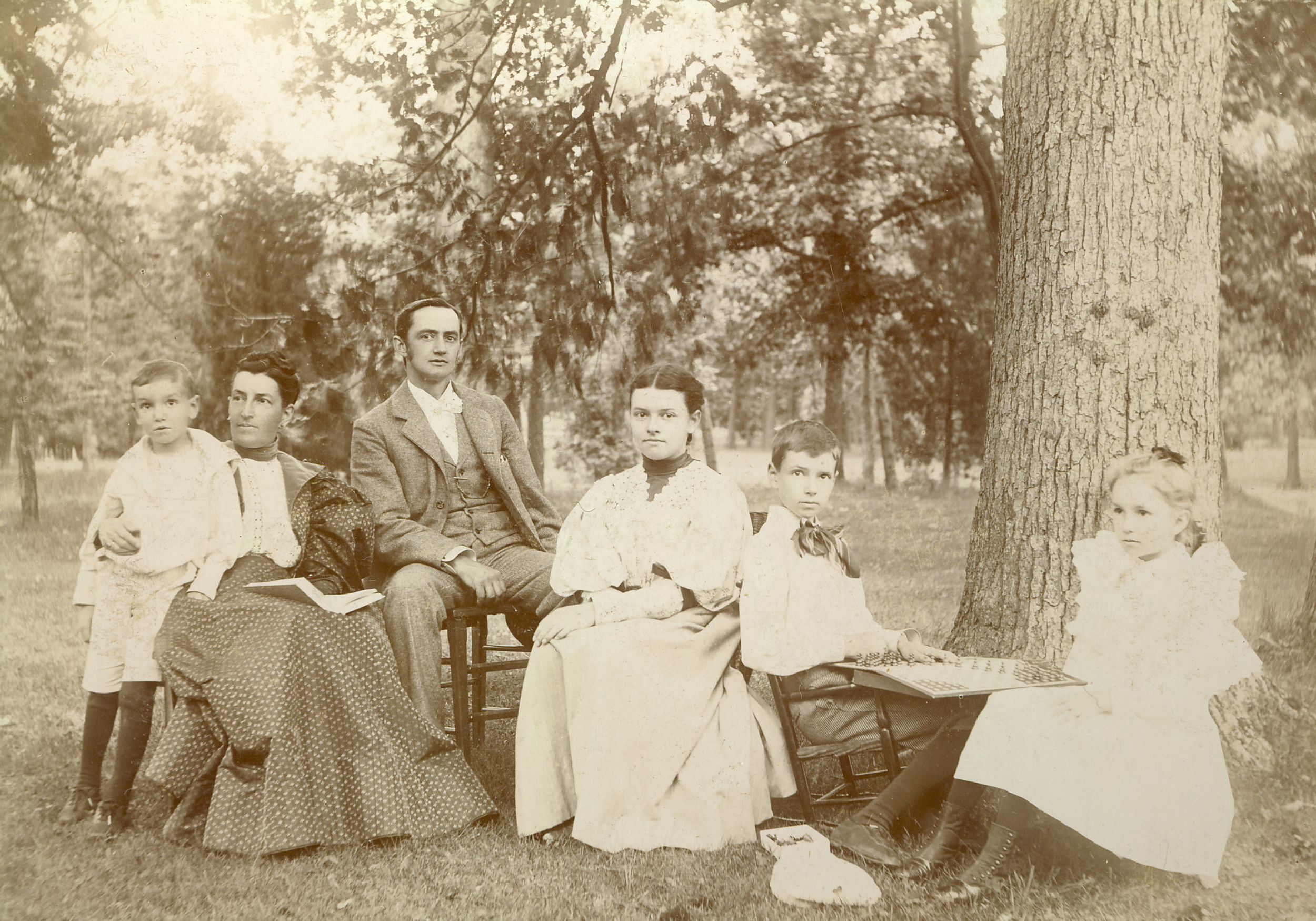
Dr. James G. K. McClure and family

The McClure-Stuart-Hart family has played such a pivotal role in Lake Forest’s history that it’s difficult to imagine their arrival in town may have hinged on the outcome of a single baseball game. James Gore King McClure was a standout baseball player in the early days of the sport; he played on a team called the Nationals in his hometown of Albany, and for the team at Yale that defeated Harvard 23-22 in 1867. When the Presbyterian elders were considering dozens of possibilities to fill First Church’s pastor vacancy in 1881, one name stood out to Charles Holt, because of that famous baseball game.
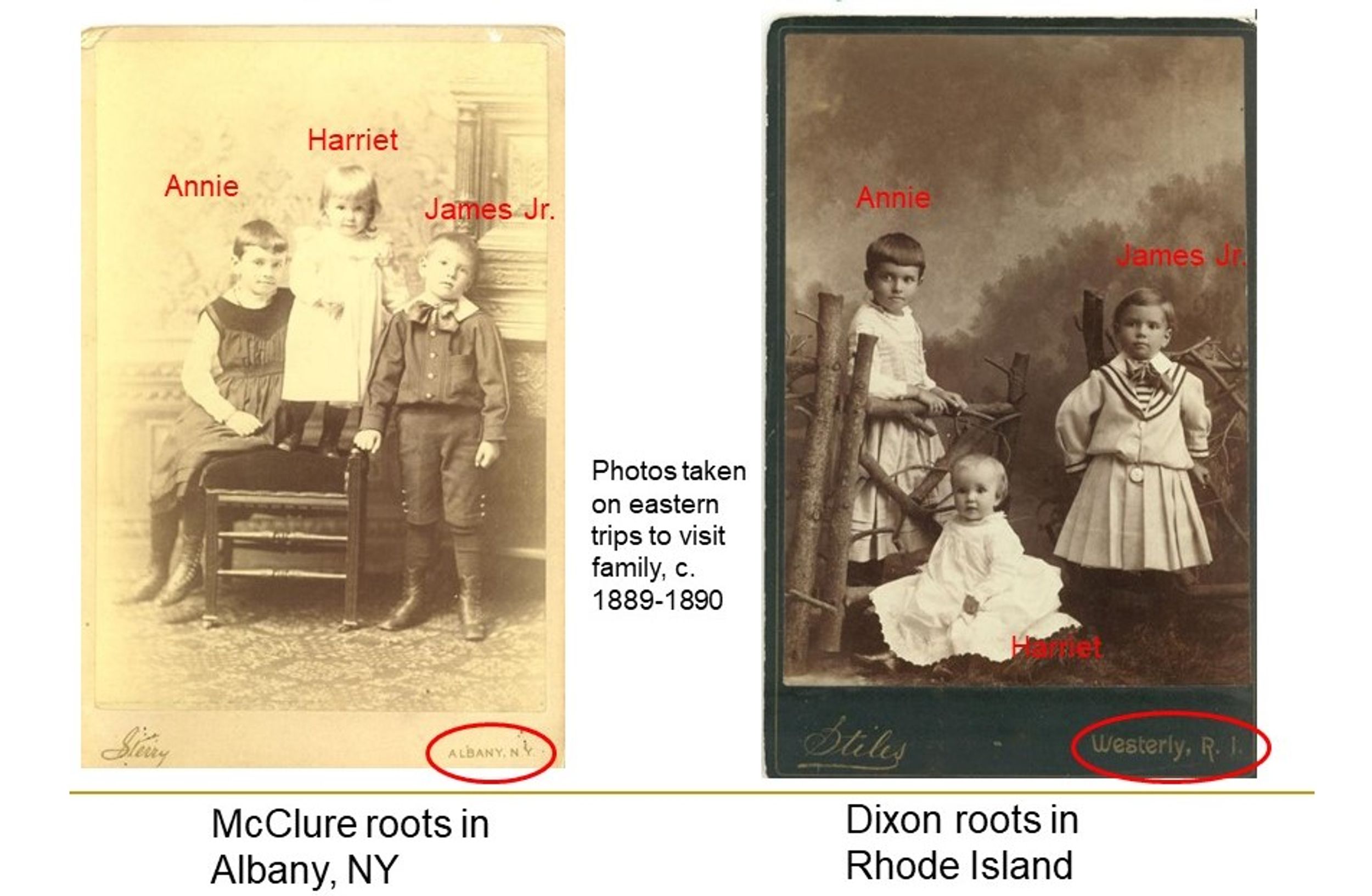
In 1881, the former baseball player and now Reverend Dr. James McClure and his new wife Annie Dixon had just returned from a year-long wedding journey. The young family seemed solidly established in the East, where their ancestry traced back to the Mayflower and their families were leading lights of Albany and Rhode Island. So when the young Dr. McClure traveled to the “West” to give four candidate sermons for a Lake Forest congregation that then had a reputation in Presbyterian circles as – let’s just say as “contentious” – it may have seemed an unlikely prospect.
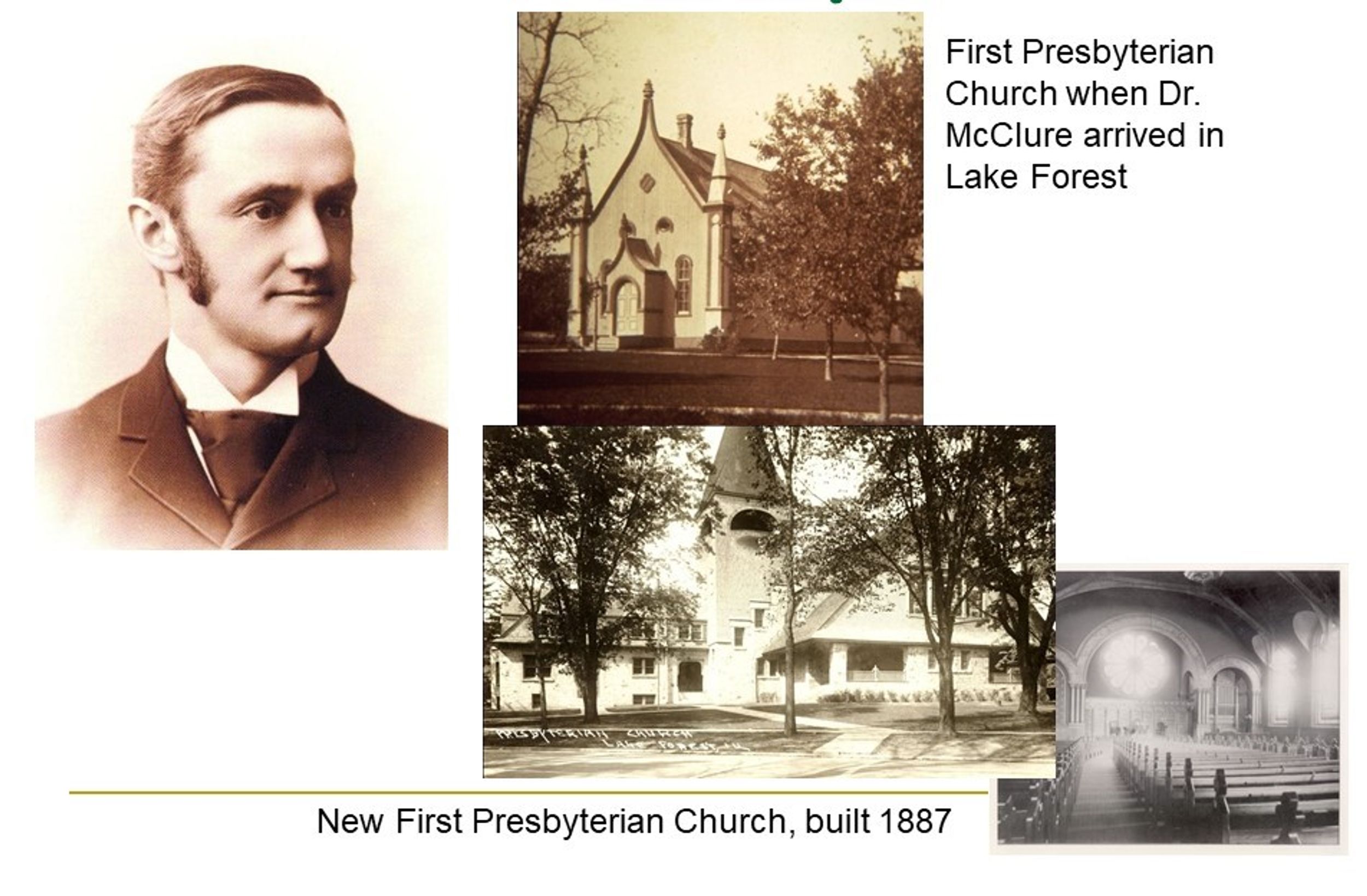
Here his baseball experience wasn’t as much help. He later remarked that it was one thing to stare down a pitcher at home plate, but still another to face a congregation from the pulpit. However, when one of his trial sermons came on the heels of the assassination attempt on U.S. President James Garfield, Dr. McClure rose to the occasion, managing to give voice to the feelings and touch the hearts of the congregation.
After he became the 4th pastor of First Presbyterian that autumn, it soon became clear that one of the major obstacles he faced was the building. The small, 1862 Gothic-style church was held off the ground only by posts and
often grew very cold. Dr. McClure later reminisced that the carpet, which flew up and down when the wind blew through holes in the floor, was known as an “undulating surface.” Most of the men – especially the Scottish ones – would bring lap shawls to church. Up at the pulpit, Dr. McClure wasn’t so lucky - he had to remove his overcoat when he stood up to preach, so he would gesture not just for emphasis, but for warmth.
With Dr. McClure’s elbow grease and ability to inspire philanthropy amongst his congregation, by 1887 the church had a beautiful new building, wherein the carpets stayed flat on the floor and such enthusiastic gesturing was no longer essential to keep from shivering.
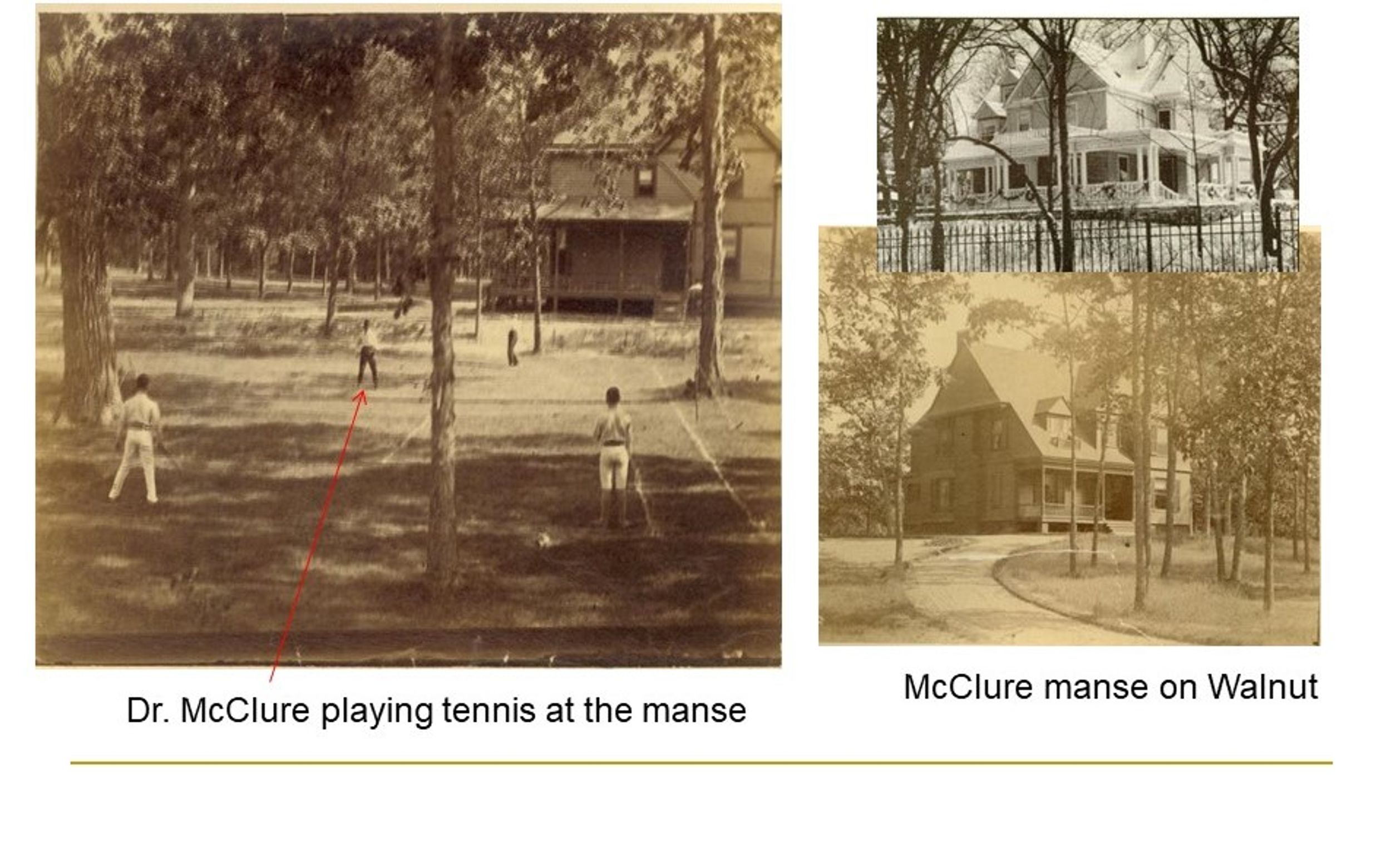
Also built in 1887 was a new manse on Walnut, which had ample yard space for tennis matches.. When Dr. McClure left First Presbyterian in 1905, this house was gifted to his family by the congregation.
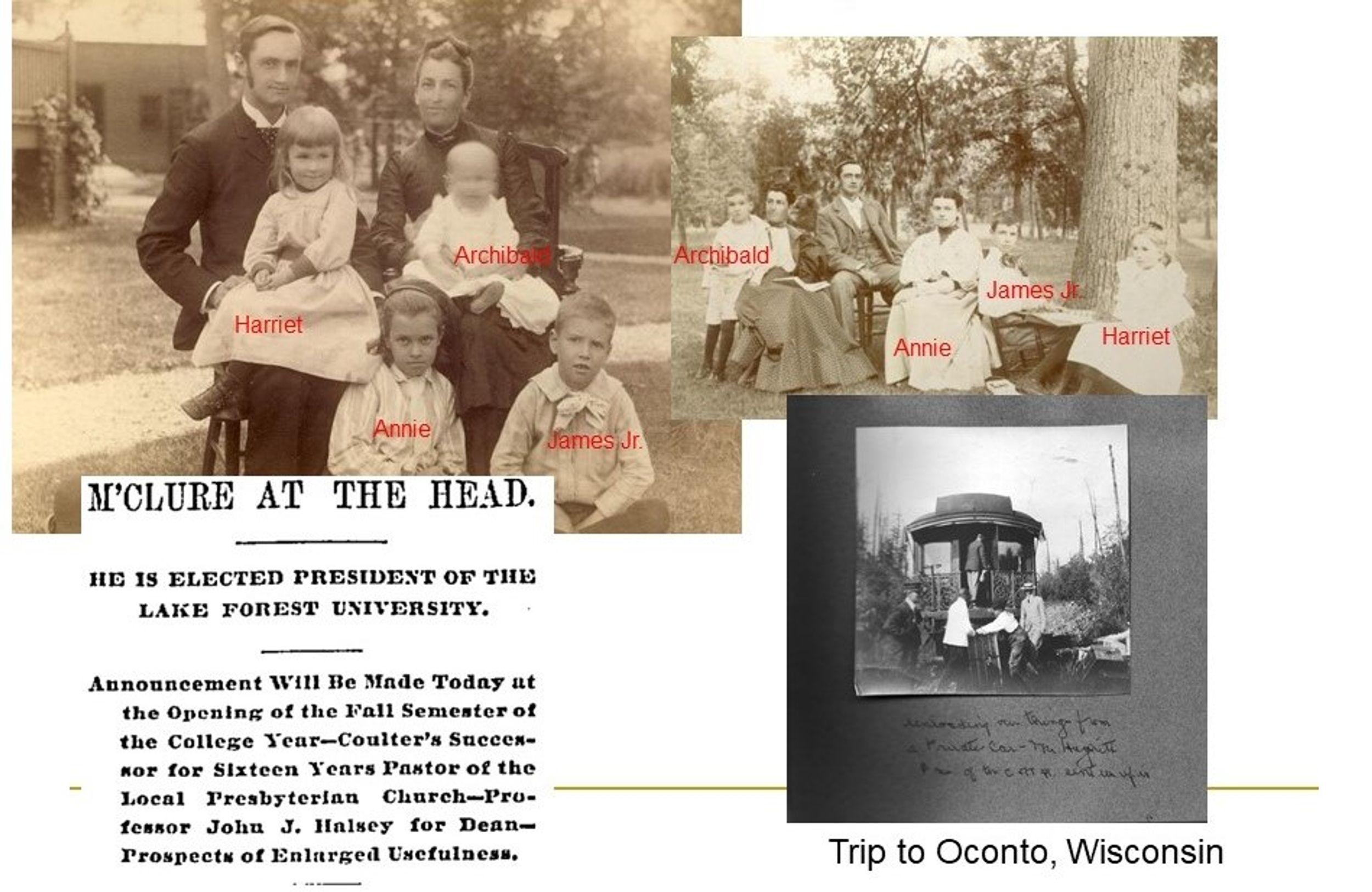
Dr. and Mrs. McClure and their growing family quickly became integrated in the daily life of Lake Forest. By the end of his pastorate, Dr. McClure had logged over 19,211 calls at the homes of his parishioners, making many dear friends in the process. Among them was Marvin Hughitt, president of the Chicago and Northwestern railroad, who lent the McClures and Holts his private car for a vacation up in Wisconsin.
Dr. McClure established himself as an indispensable pillar of the community in Lake Forest. Twice he was asked to assume the presidency of Lake Forest University, once in 1892 on an interim basis, and again officially in 1897. While still serving his congregation, his untiring efforts balanced the college’s books and prompted the construction of nearly a dozen new buildings.

The McCormick family noted the vision and accomplishments of Dr. McClure, and in 1905 urged him to become president of McCormick Theological Seminary in Chicago, where he could influence a new generation of pastors. He followed his 23 years in Lake Forest with a 22-year presidency of McCormick Seminary, finally retiring in 1927.
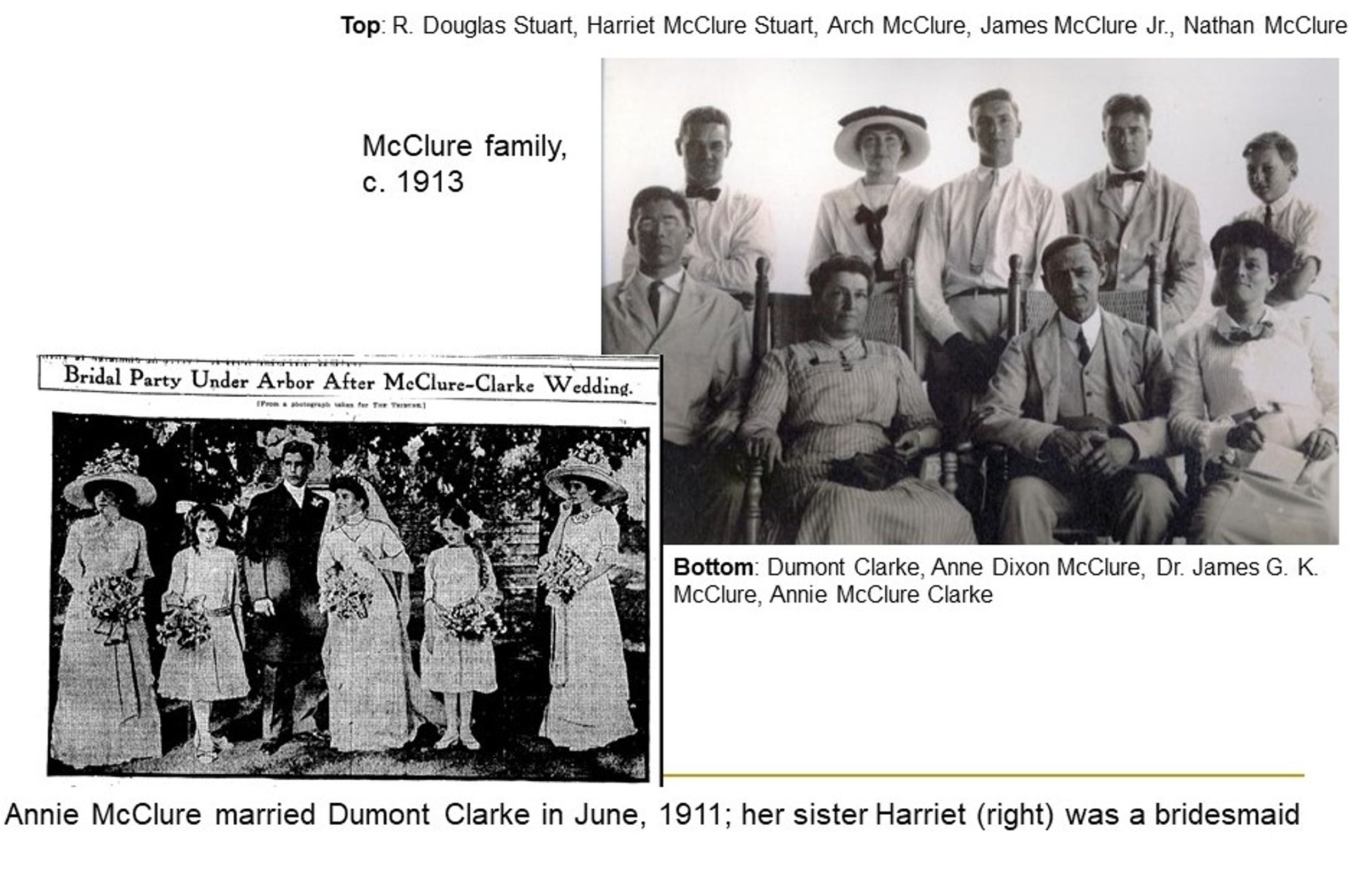
The McClures maintained their ties to Lake Forest, spending a good portion of the year at the home on Walnut. Their oldest child Annie, who always took an especial interest in her father’s work and often was his secretary, was married here in 1911.

The McClures’ younger daughter, Harriet, was always involved in some event or project. Her popularity was such that the Chicago Tribune forecasted that “Miss McClure would have the most brilliant reception of the season and her floral offerings would exceed those of any of debutante.” However this report about her debut was a little premature. Harriet was part of a strict Scotch-Presbyterian clan that valued thrift over social ritual and fancy clothes. The paper had to run a retraction and admit that Harriet “has no special day set apart for her debut” as of yet, after all.
In 1913, Harriet married Robert Douglas Stuart, whose ancestors also hailed from Scotland, by way of Canada. Milling oatmeal was a family tradition, and the Douglas-Stuart firm was part of a merger that became Quaker Oats by the turn of the century. Robert Stuart started his career at Quaker Oats as a young man in one of the company’s Ontario mills, where he earned 17 cents an hour sweeping floors and loading sacks. He ascended through the ranks, becoming a director in 1925 and president in 1942.
Shortly after the birth of his son Robert Jr., Robert Stuart Sr. went overseas as a major in the Red Cross in World War I. When he returned two years later, young Bobby was so excited that he welcomed his father home by tumbling down the stairs and splitting his head open.
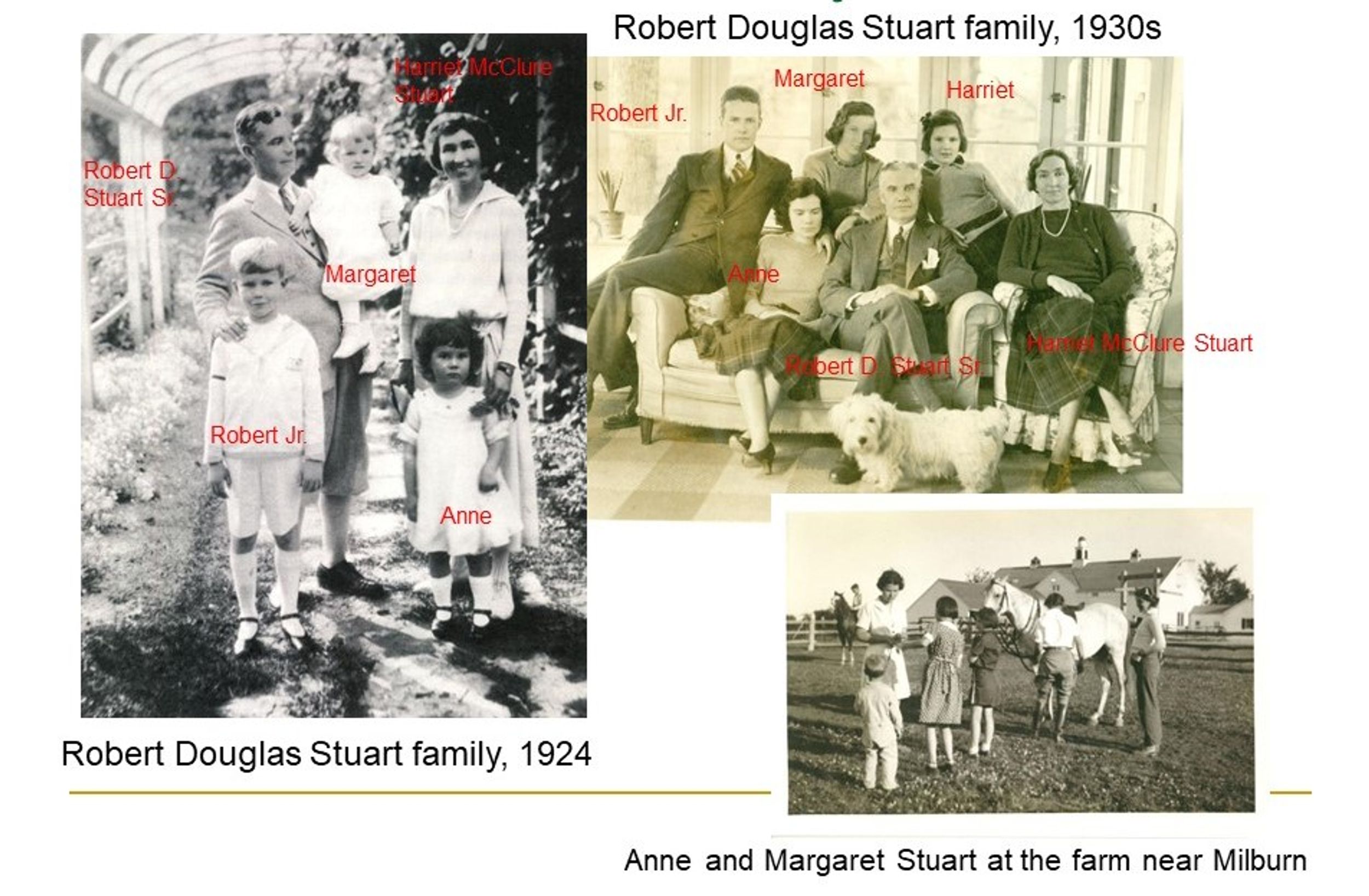
The young Stuarts grew up in a close-knit family home on Mayflower in Lake Forest. Margaret Stuart Hart remembers an illicit visit to Alice Home Hospital with her sister Anne to see their mother after their youngest sister Harriet was born. Dr. Parmenter kindly pretended he didn’t see the two little girls hiding under their mother’s bed when he came to check on his patient.
The Stuart breakfast table featured, naturally, Quaker Oats products. During one period when Quaker was trying a new milling process, Robert Sr. called on his children to help with quality control: they earned a nickel for every speck (or oat hull) they found in the oatmeal. Of course this also encouraged them to clean their bowls!
Scotch-Presbyterian values remained strong in the family, including hard work, thrift, and, especially on the McClure side, temperance. Bob Stuart recalls a youthful turn as the Prohibition police: his father asked him to fetch a present they’d received from a Canadian friend to show his mother. When the present turned out to be a bottle of Canadian whiskey, the horrified young Bobby smashed it on the stone walk in a fit of righteousness to prevent it from leading his family astray.
A love of the great outdoors also ran through the family, who would visit the family farm near Milburn on weekends for hunting and riding, and their ranch in Wyoming during the summers.
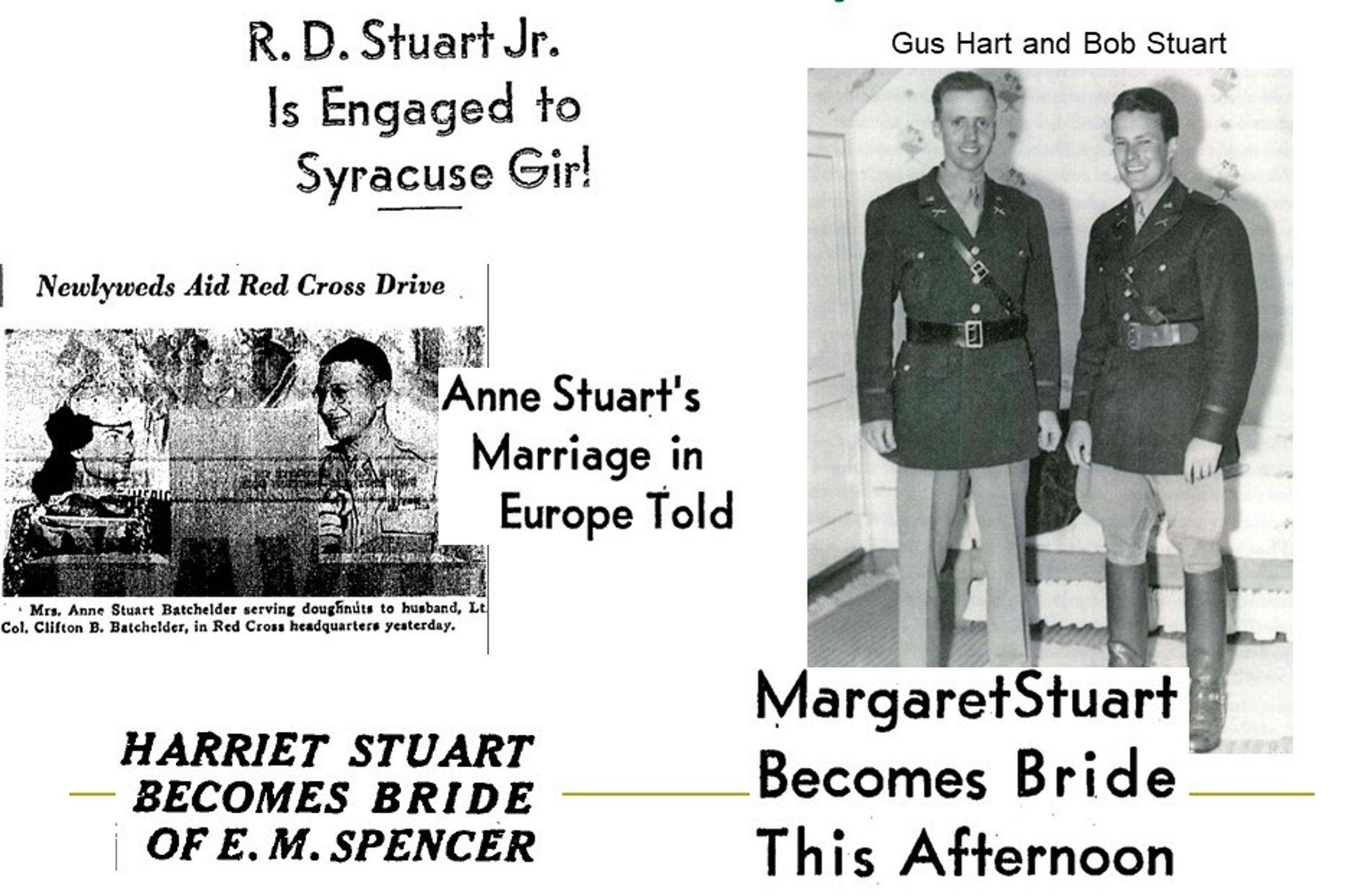
World War II was a pivotal time in the Stuart family. After Pearl Harbor, Bob and his new brother-in-law Gus Hart
both served overseas in Europe, Gus with the famous 82nd Airbourne and Bob as an aide to General Eisenhower’s
chief of staff. Bob had introduced his sister Margaret to Gus, a classmate at Princeton, on a visit to the Wyoming ranch. From there, fate took over: over Labor Day weekend, an early snowstorm trapped Gus and Margaret in a car up on the mountaintop – a romantic event even in spite of the presence of their cowboy chaperone in the car with them. They were married in 1942, with Margaret wearing her Grandmother McClure’s wedding dress and Grandmother Stuart’s lace veil.
both served overseas in Europe, Gus with the famous 82nd Airbourne and Bob as an aide to General Eisenhower’s
chief of staff. Bob had introduced his sister Margaret to Gus, a classmate at Princeton, on a visit to the Wyoming ranch. From there, fate took over: over Labor Day weekend, an early snowstorm trapped Gus and Margaret in a car up on the mountaintop – a romantic event even in spite of the presence of their cowboy chaperone in the car with them. They were married in 1942, with Margaret wearing her Grandmother McClure’s wedding dress and Grandmother Stuart’s lace veil.
Margaret and Bob’s sister Anne was married in even more dramatic fashion during the war, to a battalion commander she met while driving Red Cross trucks in France. Her wedding in Luxembourg featured dresses made from the silk of German parachutes.
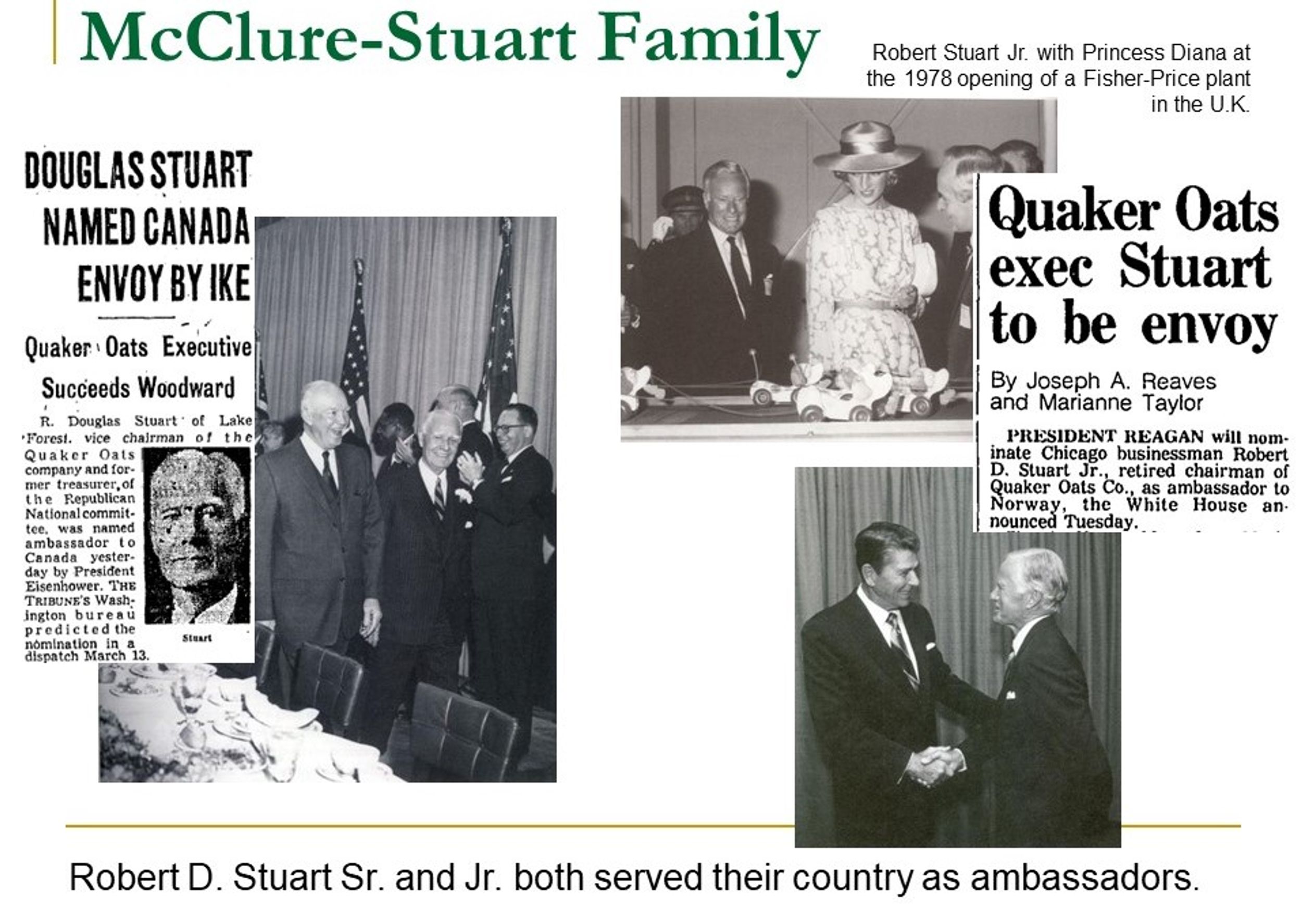
After serving as treasurer of the Republican National Committee for four years, Robert Stuart Sr. was named ambassador to Canada by President Eisenhower in 1953. This was an especially appropriate post given the Stuart family’s Canadian roots. Robert Jr. followed in his father’s footsteps, rising to become president of Quaker Oats and being nominated by President Reagan as ambassador to Norway. He learned a lesson in the etiquette of European royalty a few years before that, however, when in 1978 he had the opportunity to escort Princess Diana on a tour through a new Fisher-Price plant. He made the mistake of putting his hand on her shoulder to introduce her around when suddenly one of her bodyguards yanked him back, sternly admonishing: “Sir, we do not put our hands on royalty.”

Although the family’s concerns were international in scope, they always maintained their connection to Lake Forest. After the war, Bob Stuart had begun work at Quaker Oats in California before returning here. His growing family lived briefly in his parents’ home on Mayflower while his father was in Canada, before purchasing Topsfield Farm.
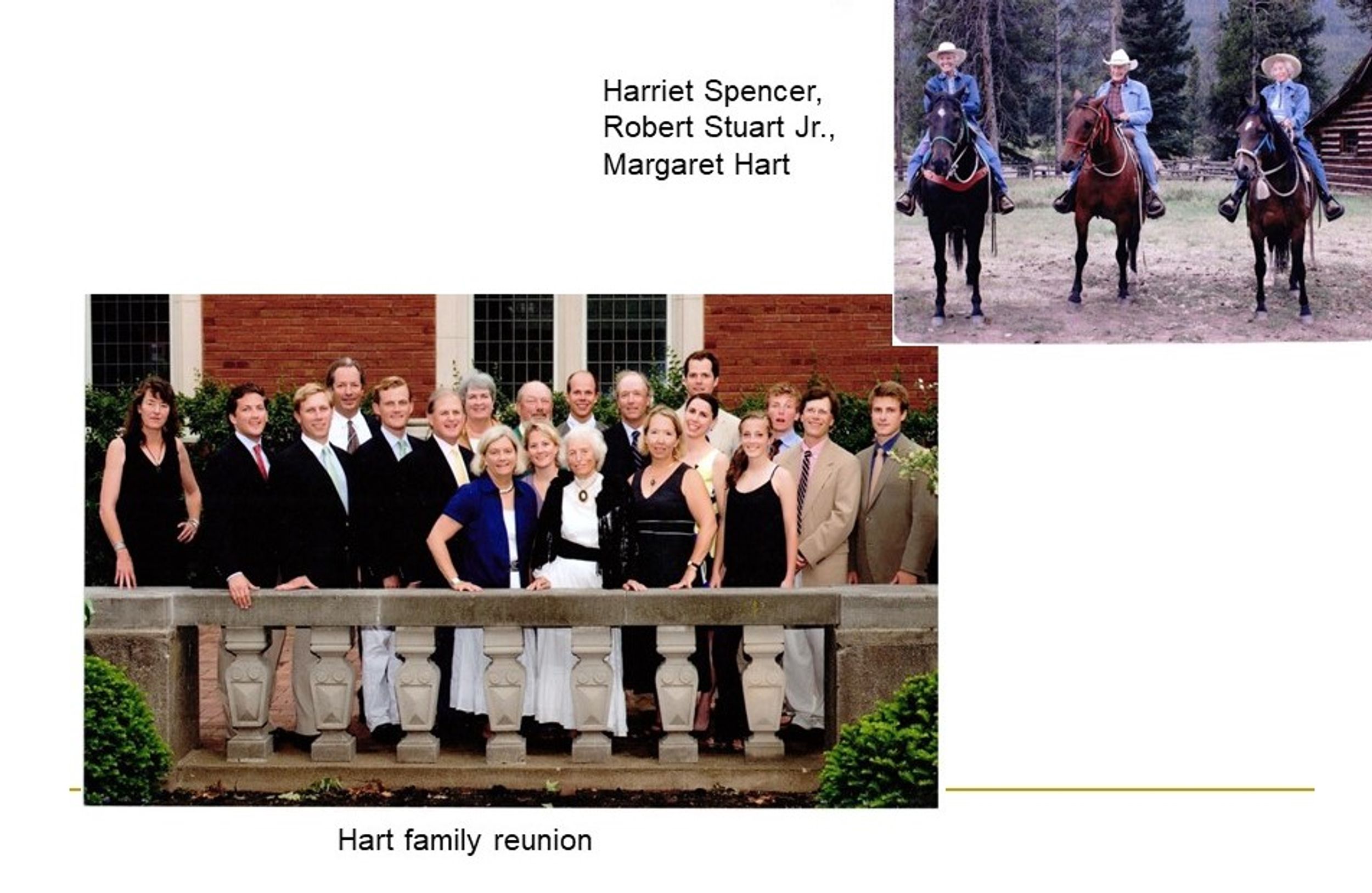
Margaret and Gus Hart also established a home in Lake Forest, on Green Bay Road. Gus worked alongside his brother-in-law at Quaker, building and managing the company’s international division. His children and grandchildren could not travel anywhere in the world without him recommending some old friend “Fred” or another to look up.
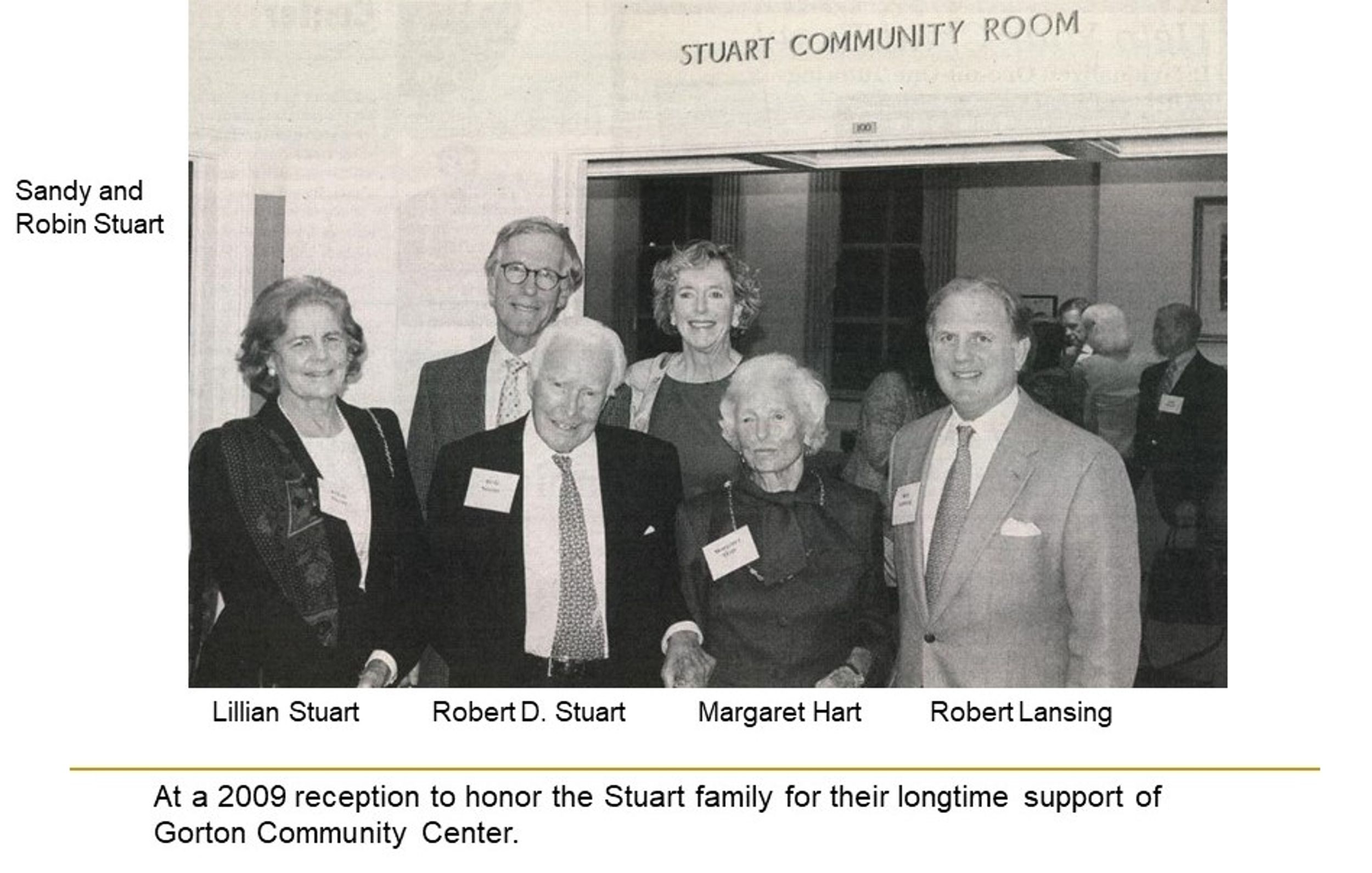
This photograph, taken in 2009, embodies the family’s commitment to the community that Dr. McClure began inspiring to higher things in 1881. They have truly made a difference in their devotion to the town’s institutions, from those like Lake Forest College and First Presbyterian Church that have seen centennials themselves to others that are more recent, like Lake Forest Open Lands, Gorton Community Center, and Conway Farms Golf Club.